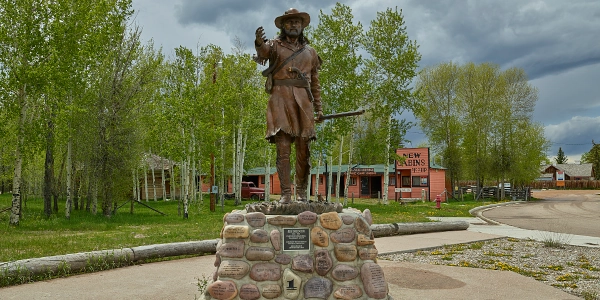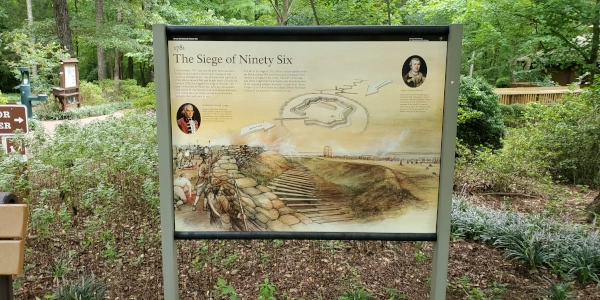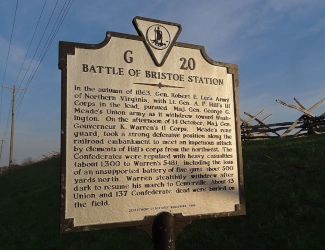
Image above: Wayside sign explaining the 1863 Battle of Bristoe Station, Virginia State Historical Marker, G20, Dumfries, Va., 2014, EMW, Courtesy Wikipedia Commons via C.C. 3.0.
Sign read, "BATTLE OF BRISTOE STATION In the autumn of 1863, Gen. Robert E. Lee's Army of Northern Virginia, with Lt. Gen. A. P. Hill's III Corps in the lead, pursused Maj. Gen. George G. Meade's Union army as it withdrew toward Wash- ington. On the afternoon of 14 October, Maj. Gen. Gouverneur K. Warren's II Corps. Meade's rear guard, took a strong defensive position along the railroad embankment to meet an impetuous attack by elements of Hill's corps from the northwest. The Confederates were repulsed with heavy casualties (about 1,300 to Warren's 548), including the loss of an unsupported battery of five guns about 500 yards north. Warren stealthily withdrew after dark to resume his march to Centerville. About 43 Union and 137 Confederate dead were buried on the field."
Spotlight on Lesser Known History
Bristoe Station, Virginia
America's Best History Spotlight
On this page we're going to Spotlight the lesser known historic sites and attractions that dot the history landscape across the USA and are worth a visit if you're in their area. And while they may be lesser known, some are very unique, and will be that rare find. You'll be, at times, on the ground floor, or maybe even know something others don't. It'll be fun. Visit them.
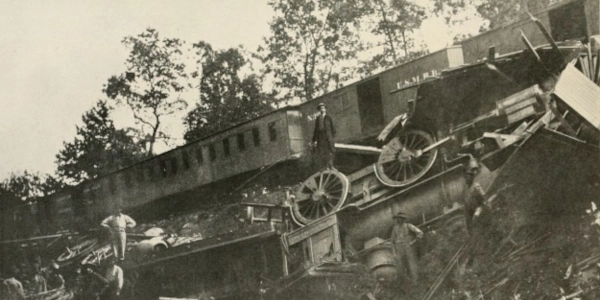
Battles of Bristoe Station, Virginia
You could say they liked it so much, they came back to battle twice. The Battle of Bristoe Station, Kettle Run, in 1862, part of the Battle for Manassas Junction Operations, and the Battle of Bristoe Station in 1863, its more major cousin, were in that way akin to the two battles at Manassas itself. That's about all the similarities as neither battle was significant in the way the Battles at Bull Run were. For the most part, they were battles that had to do with controlling the railroad systems in the area, which, in many parts, were destroyed by these actions. The worst part of these battles today, however, are how poorly they have been preserved. Despite the efforts of the Battlefield Trust and others to save some land which can be visited, the developers won most of that battle in 2021 and built homes right over top one thousand five hundred acres of the battlefield. Photo above: Train wreck during the 1st Battle of Bristoe Station, Battle at Manassas Station, on August 26, 1862, 1862, unknown author. Courtesy Wikipedia Commons.
Sponsor this page. Your banner or text ad can fill the space above.
Click here to Sponsor the page and how to reserve your ad.
Info, What's There Now, History Nearby
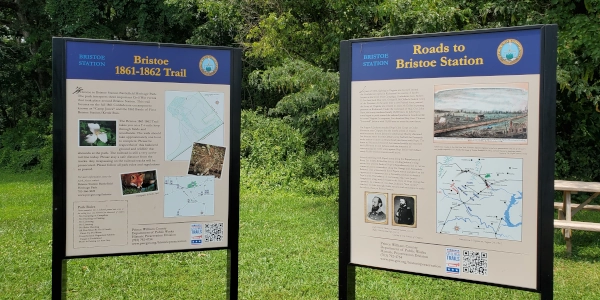
Bristoe Station, Virginia
Before we get too demoralized by the preservation loss, let's try to focus on the preservation positive. Two hundred and eighty-six acres of the battlefield was preserved by the Battlefield Trust, aka the Civil War Trust, and there is now a County Park which has trails and interpretive waysides. It's not what any Civil War historian or fan would like, but they do hold programs during anniversary weeks and some weekends from May to October so that the public can not only learn what happened during these two battles on the preserved land, but the McMansion lands as well. Sorry, I realize I'm writing a bit snippy here, so let's get back to the battles.
Image above: Trailhead and signage at the Bristoe Station Battlefield Park for the 1863 battle, 2022, America's Best History. Below: Montage of (left) Union General Gouverneur Kemble Warren, unknown date and author; and (right) Brigadier General Alexander S. Webb, 1860/1865, Brady National Photographic Art Gallery. Both courtesy Library of Congress via Wikipedia Commons.

Where Is It
Bristoe Station Battlefield Heritage Park is located just off Bristow Road (Brentsville Road on old maps), Route 619, turning south onto Iron Bridge Unit Avenue, then left onto Tenth Alabama Way. You will be traveling through a development until you reach the parking lot for the one hundred and forty acre park. Your GPS ought to be able to direct you to the park.
Minute Walk in History
Take a walk over the land where the two battles of Bristoe Station occurred, narrated by the official 1863 battle report of Union General Gouverneur K. Warren. His words are a fascinating addition to the parkland that we walked about, which include the waysides for both 1862 and 1863, with walking trails for both, as well as a winter quarters cabin.
What is There Now
Bristoe Station
One hundred and forty acres of Bristoe Station Battlefield Heritage Park, run by the county. There are trails, picnic tables, and waysides, but no restrooms or Visitor Center. One of its best traits, however, is the interpretive walks given from May to October, as of 2022, on the second and fourth weekends of the month at 11:00 a.m., 1 p.m., and 3 p.m. These times are certainly subject to change.
If you're there outside the guided walk times, there are 2.7 miles of trails that lead you to the railroad area, the Alabama Cemetery, and the Robertson Cemetery, amongst other sites.
More land has also been preserved by the Battlefield Trust, as of 2022, three hundred and nine acres have been saved. There are plans for more preservation. Some of this land is to the north of Bristoe Road just past the railroad cut, but not included in the park.
There is a mobile tour of the area available at the battlefield park website listed below.
When Open and How Much
The grounds of the battefield are open dawn to dusk. There is no charge.
Fees and hours are subject to change.
Websites
Bristoe Station Battlefield Heritage Park
Bristoe Station, Battlefield Trust
History Nearby
There is so much history within one day's drive of the Bristoe Station area that it's hard to mention all of them. Well, first, there's Manassas National Battlefield, not far up the road, and not far away will be the new Culpeper Battlefield State Park. And that's leaving out a whole lot more.
-
Manassas
-
Culpeper Battlefields
-
Washington, D.C.
-
Fredericksburg
-
Chancellorsville
-
Spotsylvania
-
Wilderness
Photos, History, and More Spotlights
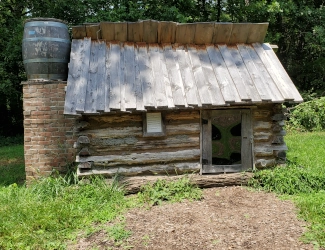
1862 Battle of Bristoe Station, Kettle Run, and Manassas Junction
For many, the battle is best known as the Battle of Kettle Run or the Battle of Manassas Operations. Kettle Run is to the west of the battlefield park. Due to the proximity to the Orange and Alexandria Railroad, Confederate camps in the area of Bristoe Station had sprung up soon after the Battle of First Manassas in the summer of 1861. It was known as Camp Jones.
During August of 1862, Stonewall Jackson had brought his troops back to Bristoe Station, captured the station, as well as the storehouses of food at Manassas Junction. A bloody battle was fought at Kettle Run on August 27, 1862. All of this was a surprise to Union General Pope, who began retreating back from the Rappahannock River to lose to Jackson at Union Mills, with Confederate General Ewell besting Major General Joseph Hooker's Union troops at Kettle Run. Nearly five hundred Union troops were lost; one hundred and seventy three Confederate.
Immediately thereafter, the Confederates marched north toward the railroad cut at the 2nd Battle of Manassas.
Photo above: Cabin used as winter quarters for Union troops, 2022, America's Best History.
Buy Second Edition
America's Best History Timeline

Great book to keep your youngsters up to date on their history and prepared for that Spring Break interview by Jesse Watters or another man or woman on the street reporter.

Battle of Bristoe Station 1863
Several months after the Battle of Gettysburg in July, both armies were trying to recouperate. As fall approached, General Lee decided that he would attempt a repeat of his Second Manassas campaign. However, this time, General Meade, now commanding the Union Army, quickly marched his troops toward Centreville. In an effort to gain knowledge of the enemy, General J.E.B. Stuart's cavalry, unfortunately got caught in between two columns of the Union Army, and needed assistance from Ewell's Corps.
There was a problem with that. In between them was the 2nd Corps of the Army of the Potomac. Its leader was General Gouveneur K. Warren. Warren only really wanted to get back to remainder of the Union Army as morning approached on October 14, 1863, however, the small battle of Auburn occurred. In the end, both Ewell and Warren reached their objectives.
This was not the end of the fighting on that day as General A.P. Hill reached Bristoe Station and thought he was in view of the rearguard of the Union Army, but not its main force. General Warren with his 2nd Corps was there as well, behind the railroad embankment. Another race ensued, this time Warren bested General Heth, and sixteen cannons fired into the Confederates charge and forced their retreat. Nearly fourteen hundred Confederates of the seventeen thousand engaged were killed, wounded, or missing. Over five hundred Union troops of the eight thousand soldiers were casualties.
Photo above: Tracks of the Orange and Alexandria Railroad destroyed by Confederates after 1863 Battle of Bristoe Station, 1863, Timothy H. O'Sullivan. Courtesy Library of Congress. Below: Drawing of General Warren fighting at Bristoe Station 1863, 1863, Alfred R. Waud. Courtesy Library of Congress.

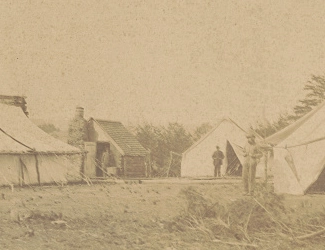
After the Battle
For the most part, the second Battle of Bristoe Station in 1863 gained no great advantage to either army. However, the arrival of General Ewell's 2nd Corps did force Warren to retreat to Centreville despite his victory. This movement allowed the Confederates to destroy the railroad, forcing Meade to rebuild it when Federal troops reoccupied the area.
By winter of 1863-4, the Pennsylvania Reserves under General Crawford were headquartered around the Bristoe area. They were to guard the Orange and Alexandria railroad. They destroyed the Davis Farmstead, the remainder of Bristoe Station, and buildings in Brentsville.
Photo above: Hospital of the 3rd Division, 5th Corps, 1864, Stewart L. Bergstresser. Courtesy Library of Congress. Below: Wayside for the Bristoe Station park interpretive trail.


T-Shirts and Gifts from the official souvenirs of Americasbesthistory.com.
About
America's Best History where we take a look at the timeline of American History and the historic sites and national parks that hold that history within their lands.
Photos courtesy of the Library of Congress, National Archives, National Park Service, americasbesthistory.com and its licensors.
- Contact Us
- About
- © 2025 Americasbesthistory.com.
Template by w3layouts.
